The Kuiper Belt is a ring-shaped disc located in the outer Solar System, extending from the orbit of Neptune, at 30 AU to more than 50 AU from the Sun. It is a comet-rich area of our solar system.
Key Facts & Summary
- The Kuiper Belt is very similar to the asteroid belt. However, it is 20 times as wide, and up to 20 to 100 times as massive.
- Both the Kuiper Belt and the asteroid belt originate from the leftovers from when the solar system formed.
- There are hundreds of thousands of Kuiper Belt objects – KBO’s – and some of them are at least 60 mi / 100 km wide, or even larger.
- These objects consist primarily of frozen volatiles such as methane, ammonia, and water. There are also three recognized dwarf planets situated in the Kuiper Belt.
- It is one of the largest structures in our solar system, the other being the Oort Cloud, heliosphere, and the magnetosphere of Jupiter.
- The inner edge of the Kuiper Belt begins at the orbit of Neptune at 30 AU from the Sun, while the inner main region extends to 50 AU and overall goes up to 55 AU or more.
- Overlapping the outer edge of the Kuiper Belt is a second region called the scattered disk, which continues outward to about 1.000 AU.
- Both the Oort Cloud and the Kuiper Belt are thought to be the main sources of comets.
- Many KBo’s experience collisions among themselves, and thus their orbits are affected. Neptune’s gravity also plays a key role in this.
- According to the Nice Model, the four gas giants may have contributed towards diminishing the original mass of the Kuiper Belt.
- The total mass of the Kuiper Belt is speculated to be less than 2%, of Earth.
- The first spacecraft to enter the Kuiper Belt region was NASA’s Pioneer 10 spacecraft in 1983. The first to actually visit a Kuiper Belt object was NASA’s New Horizons spacecraft in 2015.
- Around 15% to 20% of solar-type stars have massive Kuiper-Belt-like structures, possibly even more. Observations continue.
- Many short-period comets that have orbits of around 200 years originate from the Kuiper Belt.
Pluto was the first Kuiper Belt object to be discovered. This happened in 1930. Its discovery led astronomers to pounder the existence of Trans-Neptunian objects. The first astronomer to suggest this was Frederick Leonard who began suggesting that objects beyond Pluto exist and await to be discovered.
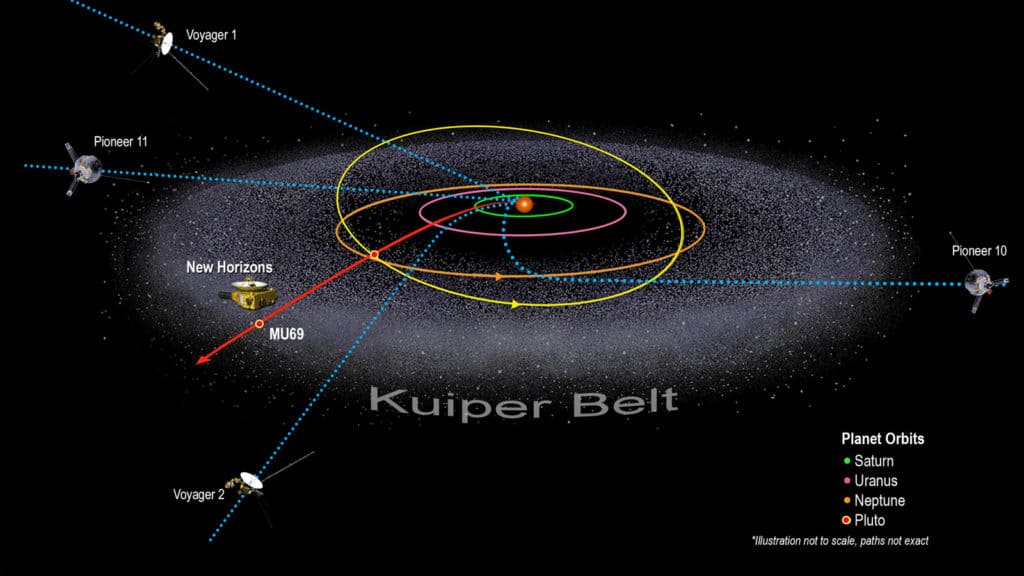
In 1943, Kenneth Edgeworth expounded upon the subject and suggested comets and larger bodies might exist beyond Neptune. Later, in 1951, Dutch astronomer Gerard Kuiper, who published a scientific paper, speculated about objects beyond Pluto. The region now called the Kuiper belt was hypothesized in various forms for decades. However, Gerard Kuiper is not responsible for its discovery. Because his ideas at the time were popular, the general idea of the belt became attributed to him. Much later, more evidence for the existence of the Kuiper belt emerged from the study of comets.
In order for comets to continue to be visible over the age of the Solar System, these objects must be replenished frequently. One such area of replenishment is the Oort cloud. However, only long-period comets come from there, and with the increasing discovery of many other short-period comets, this hypothesis was dismissed.

In 1980, Uruguayan astronomer Julio Fernández dismissed the Oort Cloud as a reservoir of short-period comets. He speculated that a comet belt that lay between 35 and 50 AU would be required to account for the observed number of comets. He published his work in the Monthly Notices of the Royal Astronomical Society paper. Following his work, a Canadian team of astronomers ran simulations to further check if comets could have arrived from the Oort Cloud.
They deduce the fact that the Oort Cloud could not account for all the short-period comets. Their simulations matched the observations of Fernández, and later, because the words “Kuiper” and “comet belt” appeared in the opening sentence of Fernández’s paper, the Canadian team named this hypothetical region the “Kuiper belt.”
In 1987, astronomer David Jewitt and then-graduate student Jane Luu used the telescopes at the Kitt Peak National Observatory in Arizona, and the Cerro Tololo Inter-American Observatory in Chile, to search the outer Solar System.
After five years of searching, on August 30th, 1992, Jewitt and Luu announced the “Discovery of the candidate Kuiper belt object” – Albion, a minor planet. Later, they discovered the second object in the region, (181708) 1993 FW – a possible dwarf planet. Many other objects were later discovered, and thus the existence of the Kuiper Belt was proven.
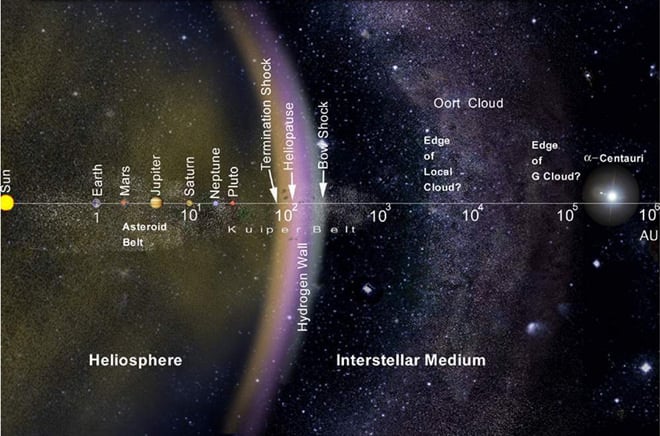
While Kuiper remains the official naming of the belt, astronomers sometimes use the alternative name Edgeworth-Kuiper belt, to credit Edgeworth for his earlier theoretical work.
However, many astronomers have gone so far as to claim that neither of these names is correct. Because of the controversy associated with its name, the term trans-Neptunian object – TNO – is recommended for objects in the belt by several scientific groups. Though, this is considered insufficient by others, since it can basically mean any object beyond the orbit of Neptune.
Formation
The origins of the Kuiper Belt and its complex structure are still unclear. The belt is thought to consist of planetesimals, fragments from the original protoplanetary disc that failed to fully coalesce into planets.
They instead formed smaller bodies, the largest having a diameter of 2,376 km / 1.476 mi. Simulations suggest that the orbits of Jupiter and Neptune strongly influenced the belt. These planets along with Uranus may have formed closer to the Sun and then migrated thus scattering the planetesimals early in the Solar System’s history.
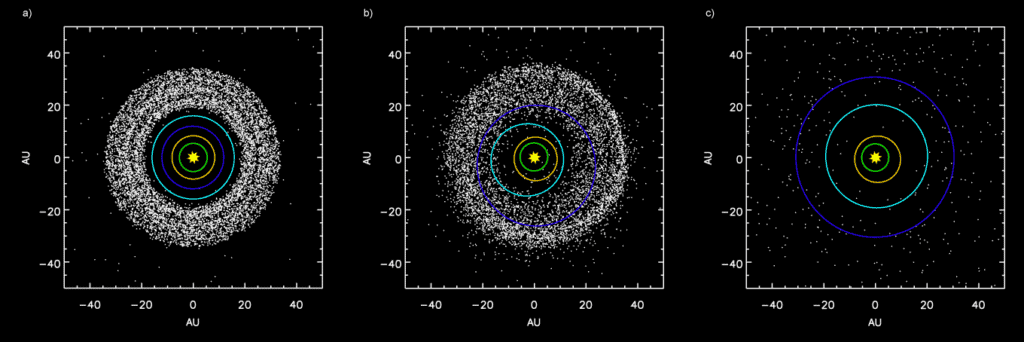
The most popular model that explains/presents the formation of the Kuiper Belt is the Nice model. This model positions the formation of the Kuiper Belt much closer to the Sun, where Neptune now orbits. As Neptune and Uranus migrated from the Sun, their gravity pushed the smaller objects farther away from the Sun.
Their orbits remain stable, often pushed back by Neptune if they get too close. Some perturbations are often credited to a hypothetical Planet X that yet remains to be either proven or disproven.
Location
The Kuiper Belt is enormous. The inner edge of the Kuiper Belt begins at the orbit of Neptune at 30 AU from the Sun, while the inner main region extends to 50 AU and overall goes up to 55 AU or more.
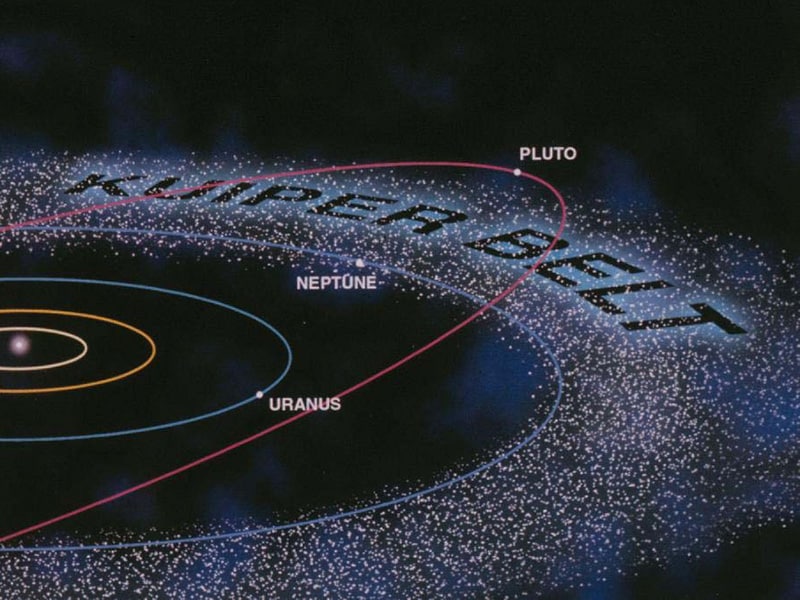
The densest section of the Kuiper Belt is between 42 and 48 AU from the Sun. It is named the classical Kuiper Belt.
Structure & Composition
The belt is quite thick, the main concentration extending as much as 10 degrees outside the ecliptic plane. Some diffuse distribution of objects extends several times farther. Neptune, due to orbital resonances, has a profound effect on the Kuiper Belt’s structure.
Its gravity destabilizes the orbits of any objects in certain regions, either sending them in the inner Solar System or out into the scattered disc or interstellar space.
Because of this, the Kuiper Belts has some pronounced gaps similar to the Kirkwood Gaps in the asteroid belt. In the region between 40 to 42 AU, objects cannot retain a stable orbit.
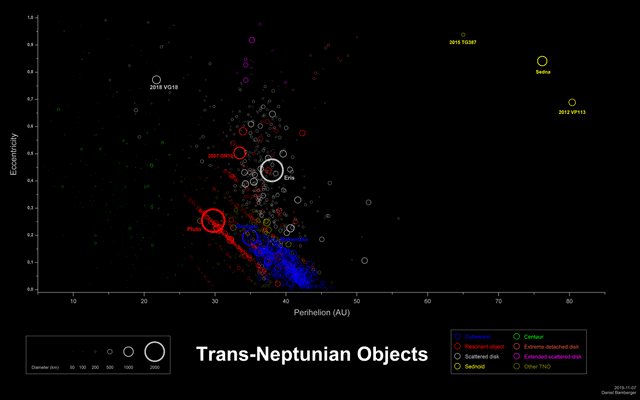
In 2:3 and 1:2 resonances with Neptune – at about 42 – 48 AU – gravitational interactions occur over an extended timescale. Many objects have their orbits unaltered. This is the classical Kuiper Belt section. The prototype for this group is considered Albion, the first modern KBO to be discovered.
This group, the classical belt, appears to be composed out of two separate populations:
1. Dynamically cold population – They have orbits similar to those of the planets, nearly circular, with an orbital eccentricity of less than 0.1, and low inclinations up to about 10 degrees. This population also contains objects named kernel, which have semi-major axes at 44 AU – 44.5 AU.
2. Dynamically hot population – They have orbits much more inclined to the ecliptic, by up to 30 degrees. Their temperature is much higher, velocity, and the largest KBO’s are part of this population such as Pluto.
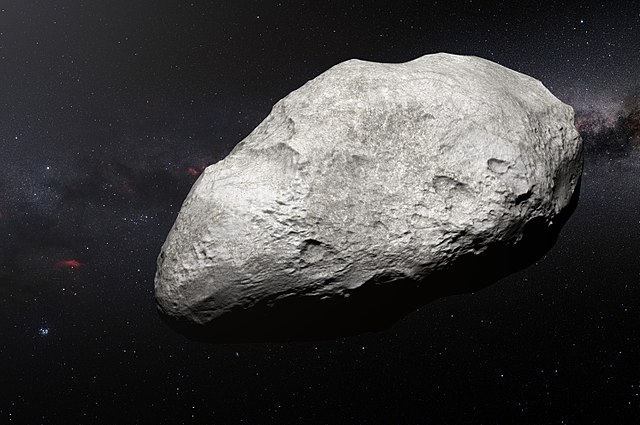
The general temperature of the belt is around 50 degrees, Kelvin. These objects consist primarily of frozen volatiles such as methane, ammonia and water. When it comes to the dwarf planet, their composition differs, being more complex and enriched. Makemake has a number of hydrocarbons, Pluto and Quaoar have surfaces rich in volatile compounds such as methane, nitrogen, and carbon monoxide.
Generally, KBOs vary in color, albedo and it is speculated that the “hot population” formed closer to the Sun, while the cold population farther.
Size and Mass
Generally, the mass of the dynamically cold population is around 30 times less than the mass of the dynamically hot population. Despite its vast extent, the mass of the hot population is estimated to about 1% that of Earth. The cold population, on the other hand, is much smaller with only 0.03% the mass of Earth.
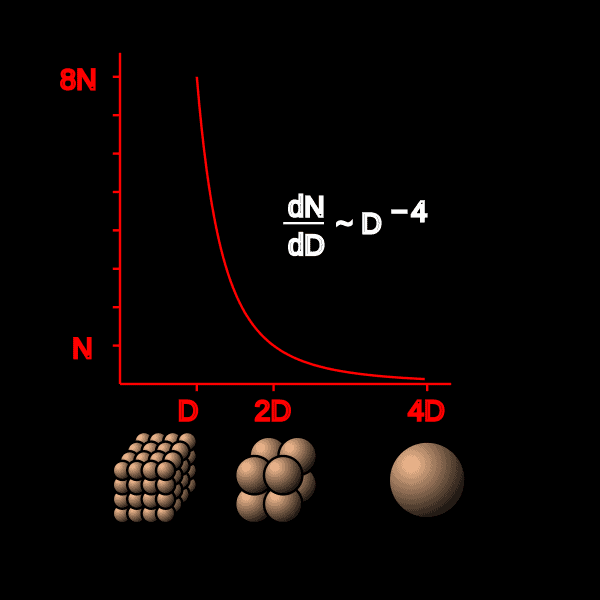
The smallest KBO detected is just 980 m across while the biggest is Pluto, with a diameter of 2,376 km / 1.476 mi. There are hundreds of thousands of Kuiper Belt objects, and most of them are at least 60 mi / 100 km wide. Since it is so vast, we haven’t yet reached the final conclusion on its overall size and mass. Some estimates revealed the presence of millions of KBOs, and other data suggest the Kuiper Belt extends beyond 55 AU.
Largest KBOs
As observations continue, more and more large KBOs are discovered. The biggest KBOs are usually categorized as dwarf planets with the largest of them is Pluto
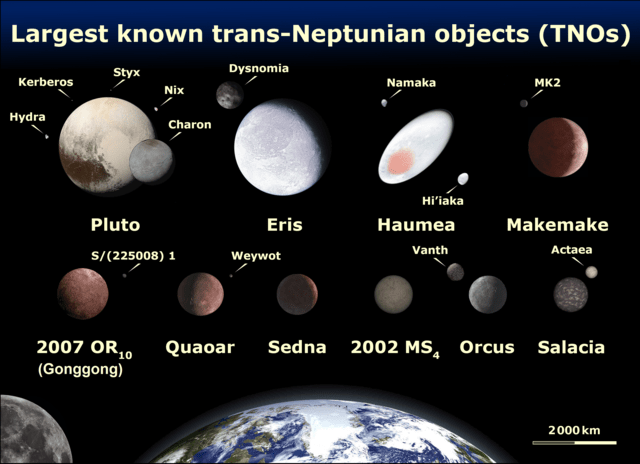
Six of the biggest KBOs that have been discovered are:
- Eris – 2.326 km / 1.445 mi
- Pluto – 2,376 km / 1.476 mi
- Makemake – 1,430 km / 888 mi
- Haumea – 1,632 km / 1.014 mi
- Quaoar – 1,110 km / 689 mi
- 2007 OR10 – 1,230 km / 760 mi
These KBOs have smaller diameters than our Moon. Certain celestial objects such as Neptune’s moon Triton is believed to be a captured KBO object. Triton is only 14% bigger than Pluto and has a similar surface composition. It is still smaller than our moon.
Scattered Objects – Scattered Disc
The scattered disc region overlaps the Kuiper Belt extending beyond 100 AU. It is a sparsely populated region with the largest SDO discovered being Eris which is often considered a KBO.
Models suggest that the Kuiper Belt and the scattered disc formed in a primordial belt. Due to gravitational interactions, mostly with Neptune, the objects were sent outward. Some objects had stable orbits –KBOs- and some had unstable orbits SDOs.
The unstable nature of SDOs is responsible for many short-period comets. They are forced into the inner solar system, first becoming centaurs, and then short-period comets.
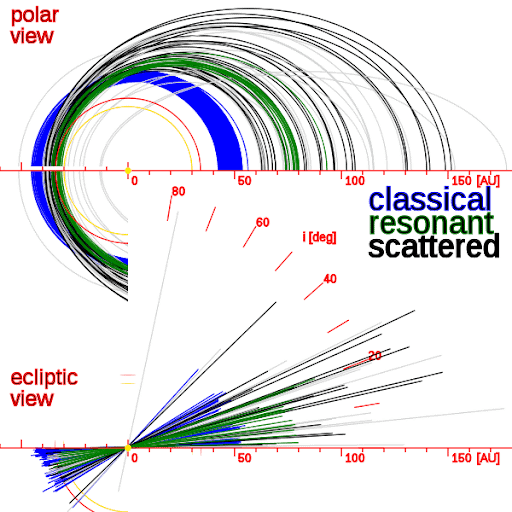
There are still debates regarding the clear definition of the Kuiper Belt, many issues remain unsolved for the time being.
Extrasolar Kuiper Belts
Around 2006, many Kuiper Belt-like structures were discovered around nine stars. They appear to fall into two categories:
- Wide belts – with radii over 50 AU
- Narrow belts – with radii between 20 to 30 AU – similar to our own.
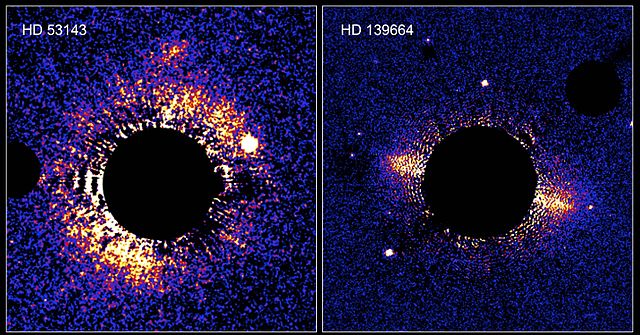
Among these stars, around 15 to 20% of solar-type stars have an observed infrared excess that is suggestive of massive Kuiper-belt-like structures. Most known debris discs around other stars are fairly young, but the two pictured above are well over 300 million years old.
Future
Objects in the Kuiper Belt either collide with one another or have a small chance to unite and become bigger objects. Some astronomers believe that the KBOs, due to increased collisions, grind each other slowly into dust, thus the Kuiper Belt may disappear in the far future.
Much of the Kuiper Belt remains unexplored, but due to its relative closeness to us, it is and will continue to be greatly studied especially since it could offer us some important answers regarding the formation of our Solar System. Observing other extrasolar Kuiper Belt-like objects also contributes to this.
Did you know?
- Many of the dwarf planets situated in the Kuiper Belt have moons of their own.
- One dwarf planet, in particular, is believed to have its own ring system, that planet is Haumea.
- Some statistics suggest that there could be over 1 trillion comet nuclei in the main body of the Kuiper Belt.
- Standard models suggest that the Kuiper Belt should have 30 times the mass of Earth, as such, around 99% of its mass is missing. The issue of the missing mass remains unresolved.
- The exact origin of the Kuiper Belt mostly remains unknown.
- Due to low temperatures, and obviously many other factors, life shouldn’t be able to manifest itself.
- Many times, astronomers invite the general public to name newly discovered celestial objects. This is true in the case of the Kuiper Belt as well.
- Currently, the last KBO to have been visited by a spacecraft is Arrokoth in early 2019.
The hunt for the hypothetical Planet X, nicknamed Planet 9, is still on-going.
Sources:
Image source:
- https://solarsystem.nasa.gov/internal_resources/3266/
- https://upload.wikimedia.org/wikipedia/commons/thumb/5/5b/Kuiper_belt_plot_objects_of_outer_solar_system.png/768px-Kuiper_belt_plot_objects_of_outer_solar_system.png
- https://www.universetoday.com/wp-content/uploads/2011/02/oort-cloud-nasa.jpg
- https://upload.wikimedia.org/wikipedia/commons/0/0f/Lhborbits.png
- https://solarsystem.nasa.gov/internal_resources/3253/
- https://upload.wikimedia.org/wikipedia/commons/thumb/9/99/KBO_diagram_eccentricity.png/640px-KBO_diagram_eccentricity.png
- https://upload.wikimedia.org/wikipedia/commons/thumb/5/52/Artist%E2%80%99s_impression_of_exiled_asteroid_2004_EW95.jpg/640px-Artist%E2%80%99s_impression_of_exiled_asteroid_2004_EW95.jpg
- https://upload.wikimedia.org/wikipedia/commons/thumb/f/fa/TheKuiperBelt_PowerLaw2.svg/600px-TheKuiperBelt_PowerLaw2.svg.png
- https://upload.wikimedia.org/wikipedia/commons/thumb/9/91/EightTNOs.png/640px-EightTNOs.png
- https://upload.wikimedia.org/wikipedia/commons/thumb/5/58/TheKuiperBelt_Projections_100AU_Classical_SDO.svg/600px-TheKuiperBelt_Projections_100AU_Classical_SDO.svg.png
- https://upload.wikimedia.org/wikipedia/commons/thumb/3/3a/Kuiper_belt_remote.jpg/640px-Kuiper_belt_remote.jpg
